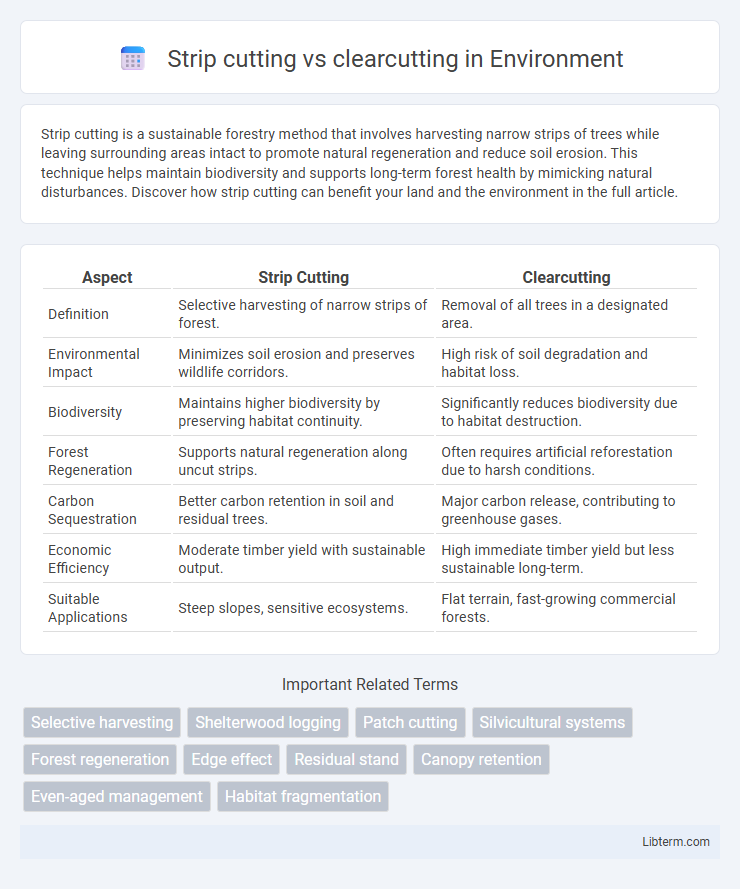Strip cutting is a sustainable forestry method that involves harvesting narrow strips of trees while leaving surrounding areas intact to promote natural regeneration and reduce soil erosion. This technique helps maintain biodiversity and supports long-term forest health by mimicking natural disturbances. Discover how strip cutting can benefit your land and the environment in the full article.
Table of Comparison
| Aspect | Strip Cutting | Clearcutting |
|---|---|---|
| Definition | Selective harvesting of narrow strips of forest. | Removal of all trees in a designated area. |
| Environmental Impact | Minimizes soil erosion and preserves wildlife corridors. | High risk of soil degradation and habitat loss. |
| Biodiversity | Maintains higher biodiversity by preserving habitat continuity. | Significantly reduces biodiversity due to habitat destruction. |
| Forest Regeneration | Supports natural regeneration along uncut strips. | Often requires artificial reforestation due to harsh conditions. |
| Carbon Sequestration | Better carbon retention in soil and residual trees. | Major carbon release, contributing to greenhouse gases. |
| Economic Efficiency | Moderate timber yield with sustainable output. | High immediate timber yield but less sustainable long-term. |
| Suitable Applications | Steep slopes, sensitive ecosystems. | Flat terrain, fast-growing commercial forests. |
Introduction to Strip Cutting and Clearcutting
Strip cutting involves harvesting narrow, linear sections of a forest, preserving adjacent strips to maintain ecosystem stability and promote natural regeneration. Clearcutting removes all trees within a designated area, creating an open space that can accelerate reforestation but may increase soil erosion and habitat disruption. Understanding these methods highlights their distinct ecological impacts and forest management objectives.
Key Differences Between Strip Cutting and Clearcutting
Strip cutting removes narrow, linear sections of trees, preserving surrounding vegetation for ecological benefits such as habitat continuity and reduced soil erosion. Clearcutting involves removing all trees in a designated area, maximizing timber yield but significantly altering wildlife habitats and increasing erosion risks. The choice between strip cutting and clearcutting impacts forest regeneration patterns, biodiversity conservation, and land-use sustainability.
Environmental Impact: Strip Cutting vs Clearcutting
Strip cutting minimizes soil erosion and preserves biodiversity by retaining strips of vegetation, while clearcutting often leads to habitat loss, increased runoff, and soil degradation. The selective removal in strip cutting helps maintain microclimates and water quality, contrasting with the stark environmental disturbances caused by complete canopy removal in clearcutting. Forest regrowth tends to be more resilient and diverse following strip cutting, supporting long-term ecosystem stability.
Effects on Biodiversity and Wildlife
Strip cutting maintains higher biodiversity and supports wildlife by preserving continuous forest corridors, allowing species movement and habitat diversity. Clearcutting causes significant habitat loss, fragmentation, and decreases species richness by removing all vegetation, leading to long-term ecological disruption. Studies show strip cutting promotes quicker ecosystem recovery and sustains populations of sensitive and edge species compared to clearcutting's more severe impacts.
Soil Erosion and Water Quality Comparison
Strip cutting reduces soil erosion by maintaining alternating strips of vegetation that stabilize the soil, whereas clearcutting exposes large soil areas to erosion from rain and wind. The presence of vegetation in strip cutting improves water infiltration and reduces sediment runoff, leading to better water quality in nearby streams and rivers. Clearcutting often results in increased sedimentation and nutrient runoff, degrading aquatic habitats and impairing water quality more significantly than strip cutting.
Regeneration and Forest Recovery Rates
Strip cutting promotes faster forest regeneration by leaving alternating strips of mature trees that provide seed sources and protect soil, enhancing natural recovery rates compared to clearcutting. Clearcutting, which removes all trees in an area, often leads to slower regeneration due to increased soil erosion and loss of seed sources, resulting in extended recovery periods. Studies show strip cutting can reduce forest recovery time by up to 30%, supporting biodiversity and maintaining habitat continuity more effectively than clearcutting.
Economic Considerations and Timber Yield
Strip cutting maximizes economic returns by allowing partial timber harvest while maintaining forest regeneration, leading to sustained yields and reduced replanting costs. Clearcutting provides a higher immediate timber yield per unit area, offering rapid revenue but often incurring greater environmental restoration expenses over time. Timber markets value strip cutting for its balance between continuous supply and ecosystem management, whereas clearcutting suits operations prioritizing short-term profit and large-volume extraction.
Suitability for Different Forest Types
Strip cutting is highly suitable for mixed and uneven-aged forests, preserving biodiversity and soil stability by retaining buffer zones, while clearcutting is more appropriate for even-aged, fast-growing species like pine or spruce where uniform regeneration is desired. Forests with sensitive ecosystems or steep slopes benefit from strip cutting, reducing erosion risks and maintaining wildlife corridors, whereas clearcutting can lead to significant habitat disruption and increased vulnerability in these areas. Choosing the right method depends on forest composition, ecological sensitivity, and management objectives focused on sustainability and regeneration.
Sustainable Forestry Practices: Which Is Better?
Strip cutting preserves more biodiversity and reduces soil erosion compared to clearcutting by harvesting trees in narrow strips while maintaining continuous forest cover. Clearcutting often leads to habitat loss and nutrient depletion, making it less sustainable for long-term ecosystem health. Sustainable forestry practices favor strip cutting for its balance between timber production and environmental conservation.
Conclusion: Choosing the Right Harvesting Method
Strip cutting preserves soil stability and biodiversity better than clearcutting, making it ideal for sensitive ecosystems. Clearcutting maximizes timber yield and reduces costs but can lead to increased erosion and habitat loss. Selecting the right harvesting method depends on forest management goals, site conditions, and environmental impact considerations.
Strip cutting Infographic

 libterm.com
libterm.com